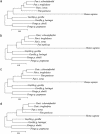Morphometrics and hominoid phylogeny: Support for a chimpanzee-human clade and differentiation among great ape subspecies
- PMID: 15070722
- PMCID: PMC384751
- DOI: 10.1073/pnas.0306235101
Morphometrics and hominoid phylogeny: Support for a chimpanzee-human clade and differentiation among great ape subspecies
Abstract
Taxonomic and phylogenetic analyses of great apes and humans have identified two potential areas of conflict between molecular and morphological data: phylogenetic relationships among living species and differentiation of great ape subspecies. Here we address these problems by using morphometric data. Three-dimensional landmark data from the hominoid temporal bone effectively quantify the shape of a complex element of the skull. Phylogenetic analysis using distance-based methods corroborates the molecular consensus on African ape and human phylogeny, strongly supporting a Pan-Homo clade. Phenetic differentiation of great ape subspecies is pronounced, as suggested previously by mitochondrial DNA and some morphological studies. These results show that the hominoid temporal bone contains a strong phylogenetic signal and reveal the potential for geometric morphometric analysis to shed light on phylogenetic relationships.
Figures


References
-
- Ruvolo, M. (1997) Mol. Biol. Evol. 14, 248–265. - PubMed
-
- Satta, Y., Klein, J. & Takahata, N. (2000) Mol. Phylogenet. Evol. 14, 259–275. - PubMed
-
- Groves, C. P. (1986) in Comparative Primate Biology I: Systematics, Evolution, and Anatomy, eds. Erwin, J. & Swindler, D. R. (Liss, New York), pp. 187–217.
-
- Begun, D. R. (1992) Science 257, 1929–1933. - PubMed
-
- Begun, D. R. (1994) Yearb. Phys. Anthropol. 37, 11–63.
Publication types
MeSH terms
LinkOut - more resources
Full Text Sources
Research Materials
Miscellaneous

